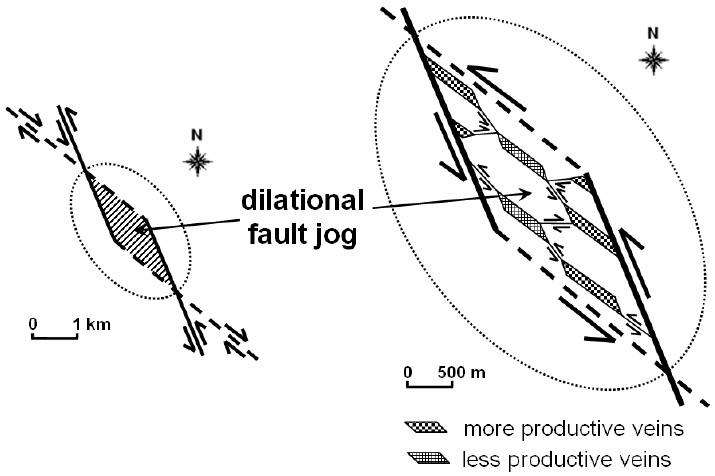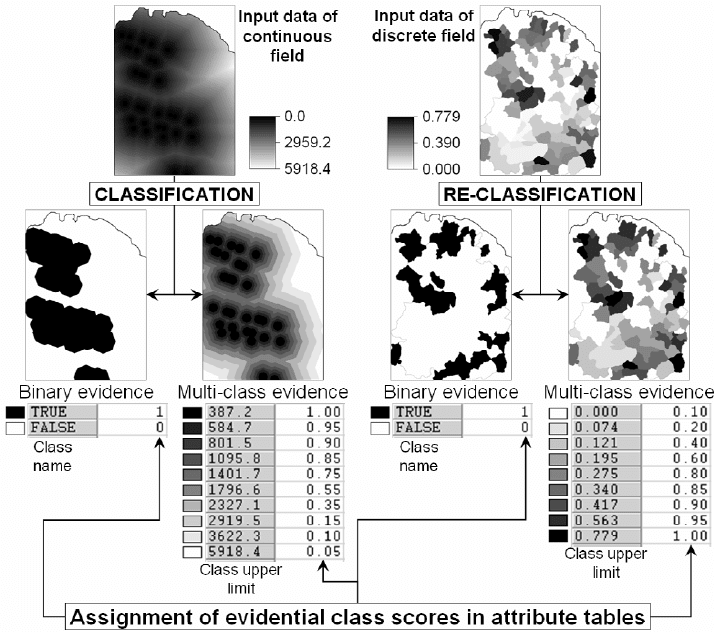Carranza E. Geochemical anomaly and mineral prospectivity mapping in GIS
Подождите немного. Документ загружается.


182 Chapter 6
faults/fractures (i.e., proximal-
jyjx
dd
r > distal-
jyjx
dd
r ), within which all the centroids
of mapped units of Nabongsoran Andesite porphyry are present. These results are similar
to the results of the distance distribution analysis (see Figs. 6-10C and 6-10D).
Synthesis and discussion of results
Table 6-IX shows that, in the applications of the distance distribution method and the
distance correlation method in the case study area, the former method results in larger
distances of optimum positive spatial associations between the point geo-objects of
interest and individual sets of geological features. This is usually not the case as shown
by previous comparisons between the two methods (Carranza, 2002; Carranza and Hale,
2002b). The differences between the results of the two methods are attributable to the
discretisation of the distance data (see step 2) in the application of the distance
distribution method, whereas there is no discretisation of the distance data in application
of the distance correlation method.
The similar results of applications of the distance distribution method and the
distance correlation method presented in this volume further demonstrates the usefulness
of the former method in characterising spatial associations of a set mineral deposit
occurrences and individual sets of linear or point geological features. An important
advantage of the distance correlation method over the distance distribution method is
that the former provides meaningful results even though it makes use of only linear (or
point) geological features that are closest to the known occurrences mineral deposits of
interest. This is an advantage because, in many cases, localities of mineral deposit
TABLE 6-VII
Factors related to position of an AP (arbitrary point) with respect to every ⊥L
i
that render
satisfactory results (table entries in bold or highest final ranks) and unsatisfactory results in the
application of the distance correlation method. Results shown are based on analysis of the spatial
association between centroids of mapped units of Nabongsoran Andesite porphyry and
intersections of NNW- and NW-trending faults/fractures in Aroroy district (Philippines).
Factor 1: mean of angles
formed by an AP with ⊥L
i
Factor 2: mean coefficients of
variation* of d
jy
along ⊥L
i
Combination of
factors 1 and 2
AP
Value Rank (1) Value Rank (2)
(1)×(2)
Final rank
S 61º 7 0.049 7 98 9
E 31º 5 0.038 6 60 8
C 26º 3 0.077 9 54 7
NW 47º 6 0.029 4 48 6
N 29º 4 0.034 5 40 5
W 63º 8 0.015 2 32 4
SE 72º 9 0.008 1 18 3
SW 11º 1 0.076 8 16 2
NE 18º 2 0.021 3 12 1
*Ratio of standard deviation to mean.

Analysis of Geologic Controls on Mineral Occurrence 183
occurrences are relatively well-mapped than other portions of a study area. Thus, the
distance correlation method is a useful exploratory analytical tool in determining which
relevant geological features should be given preferential attention in further field
geological mapping or geological remote sensing of poorly explored portions of a study
area. The main disadvantage of the distance correlation method is that, being a non-
parametric method, it does not provide a statistical test of significance of spatial
association. However, it allows for empirical testing of spatial association by estimation
of the proportion of mineral deposit occurrences within the derived distance of optimal
TABLE 6-VIII
Results of distance correlation calculations to quantify spatial association between centroids o
f
Nabongsoran Andesite porphyry and intersections of NNW- and NW-trending faults/fractures,
Aroroy district (Philippines). Table entries in bold pertain to optimal spatial association.
AP
rj
Y max
(m)
jyjx
dd
r
t-value*
Proximal-
jyjx
dd
r Distal-
jyjx
dd
r
C 600 0.9978 21.320 0.9904 0.9899
E 700 0.9858 8.306 0.9845 0.9833
S 700 0.9969 17.996 0.9941 0.9940
NW 700 0.9969 13.453 0.9945 0.9925
* Calculated values of
jyjx
dd
r are significantly different from zero; the critical t-value at α=0.01
and
ν
=4-2=2 de
g
rees of freedom is 6.965
(
Davis, 2002
)
.
TABLE 6-IX
Summary of results of analyses of spatial associations between epithermal Au deposit occurrences
and individual sets of structural features in Aroroy district (Philippines). Table entries in bold
relate to the results of analyses of the spatial distribution of the epithermal Au deposit occurrences
in the case study area (see above).
Results of distance
distribution analysis
Results of distance
correlation analysis
Average of results
Geological
features*
D** (m)
Percentage o
f
Au (or NAC)
within D
D** (m)
Percentage o
f
Au (or NAC)
within D
D** (m)
Percentage o
f
Au (or NAC)
within D
Au vs. NNW 450 100 200 69 325 84.5
Au vs. NW 1000 85 800 69 900 77.0
Au vs. FI 1100 85 900 77 1000 81.0
Au vs. NE 250 55 300 62 275 58.5
NAC vs. FI 800 100 700 100 750 100
*Au = epithermal Au deposit occurrences; NAC = centroids of mapped units of Nabongsoran
Andesite porphyry; NNW = NNW-trending faults/fractures; NW = NW-trending faults/fractures;
FI = intersections of NNW- and NW-trending faults/fractures; NE = NE-trending faults/fractures.
**D = distance of o
p
timum
p
ositive s
p
atial association.
184 Chapter 6
spatial association with nearest neighbour linear or point geological features. A
limitation of the distance correlation method is that it is not applicable to the analysis of
spatial association between mineral deposit occurrences and geochemical anomalies.
The observed differences in the results of the distance distribution method and the
distance correlation method illustrate, however, that spatial associations of mineral
deposit occurrences and certain geological features can only be quantitatively explored
but cannot be definitely confirmed. Nevertheless, the results of analyses of spatial
associations between mineral deposit occurrences and certain geological features can
provide ideas for new investigations that may lead to further understanding of geologic
controls on occurrences of mineral deposits of the type sought in a particular area. For
example, the similar results of the applications of the distance distribution method and
distance correlation method that there is positive albeit very weak spatial association
between the epithermal Au deposit occurrences and NE-trending faults/fractures in the
case study area (Table 6-IX) suggest that the set of all NE-trending faults/fractures (see
Fig. 5-13) probably represents various processes or structural regimes. However,
because the distance correlation method makes use of only linear (or point) geological
features that are closest to the known occurrences of mineral deposits of interest, it is
plausible that the epithermal Au deposits in the study area are associated with only one
of the possible various structural regimes represented by the NE-trending
faults/fractures. More importantly, the results of analyses of spatial associations between
mineral deposit occurrences and certain geological features in conjunction with the
results of analyses of spatial distribution of mineral deposit occurrences are useful in
defining a conceptual model of mineral prospectivity.
From the results of analyses of spatial associations between the epithermal Au
deposit occurrences and individual sets of geological features shown in Table 6-IX, it is
possible to rank the examined geological features according to their relative importance
to the occurrence of mineral deposits of the type sought. Note that, as stated earlier, the
smaller the distance of positive spatial association, the stronger the spatial dependence.
This proposition can be supported by estimation of likelihood of mineral deposit
occurrence as the ratio of the proportion (or percentage) of deposits in zones within the
distance of optimum positive spatial association with a set of certain geological features
to the proportion (or percentage) of zones in a study area within that distance from the
same set of geological features. This analysis is supported directly by the distance
distribution method [i.e., dividing Ô(X) by Ê(X)] but can also be derived based on the
results of the distance correlation method. Thus, the following recognition criteria of
prospectivity for epithermal Au deposits, arranged according to decreasing importance,
are postulated for the case study area:
proximity to NNW-trending faults/fractures (representing structural controls);
proximity to intersections of NNW- and NW-trending faults/fractures (representing
structural controls and proxy for heat source controls); and
proximity to NW-trending faults/fractures (representing structural controls).
By integrating these interpretations with those derived from the analyses of spatial
distribution of the epithermal Au deposit occurrence, a conceptual model of structural

Analysis of Geologic Controls on Mineral Occurrence 185
control on epithermal mineralisation in the case study area can be drawn (Fig. 6-16) and
postulated as follows.
The stronger positive spatial association of the epithermal Au deposit occurrences
with the NNW-trending faults/fractures than with the NW-trending faults/fractures
suggests that the former were the more active structural controls on the formation of the
epithermal Au deposits. Dilational jogs or zones of extension faults/fractures, arising
from en echelon NNW-trending strike-slip faults/fractures or from intersections of the
NNW- and NW-trending strike-slip faults/fractures (see Fig. 6-7), provided conditions
(i.e., structural permeability and hydrothermal fluid flow) that favoured epithermal
mineralisation (Fig. 6-16). On regional- to district-scales, hydrothermal fluids were
circulated or focused towards dilational jogs or intersections of strike-slip faults/fractures
(e.g., Laing, 2004) during seismic activity (cf. Sibson, 1987, 1996, 2000, 2001; Bellot,
2008). Then, on a local-scale, hydrothermal fluids were focused towards extension
faults/fractures in a mesh of interlinked shear faults/fractures and extension
faults/fractures within dilational jogs (cf. Blenkinsop and Kadzviti, 2006; Nelson, 2006).
These interpretations of presence of regional- to local-scale dilational jogs and regional-
Fig. 6-16. Conce
p
tual model of structural control on epithermal mineralisation in the Aroroy
district (Philippines). Dilational jogs or zones of extension arise from en echelon strike-slip
fault/fracture segments or from intersections of strike-slip faults/fractures (see Fig. 6-7). In case o
f
the former in the study area, a set of conjugate shears (in this case the dashed NW-trending faults)
is possibly relatively passive. Within a dilational jog, a mesh of interlinked shear faults/fractures
and extension faults/fractures is developed and the extension faults/fractures are favourable sites
for deposition of epithermal veins. See text for further explanation.
186 Chapter 6
to local-scale intersections of strike-slip fault/fractures represent the results of the fractal
analysis. The hydrothermal fluids were further dispersed, however, outwards from the
center of a dilational jog, but they were trapped by the major NNW-trending strike-slip
faults/fractures bordering a dilational jog. Thus, it can be hypothesised that less
productive or barren epithermal veins formed at the central parts of a dilational jog (or
intersection of NNW- and NW-trending faults/fractures) whereas more productive
epithermal veins formed close to major NNW-trending strike-slip faults/fractures
bordering a dilational jog. These interpretations represent the quantified spatial
associations between epithermal Au deposit occurrences and the NNW-trending
faults/fractures, NW-trending faults/fractures and intersections of these two sets of
faults/fractures and the field observations that Au-bearing quartz veins in the study area
are associated mostly with NNW-trending faults/fractures (Mitchell and Leach, 1991) .
In addition to the above-mentioned prospectivity recognition criteria, which
constitute a conceptual model of geologic controls in the case study area, the following
non-geologic control is an important prospectivity recognition criterion to consider:
presence of multi-element stream sediment geochemical anomalies (representing
surficial expressions or evidence).
A conceptual model of geologic controls and surficial expressions of mineral deposits of
the type sought, which can be referred to as a deposit exploration model, provides the
theoretical framework for mineral prospectivity mapping.
CONCLUSIONS
Because the geological processes involved in mineralisation are too complex to be
modeled in a GIS in order to predict prospective areas for further exploration, a
conceptual model of geologic controls on mineralisation forms the basis of GIS-based
modeling of mineral prospectivity. A conceptual model of geologic controls on
mineralisation is usually a synthesis of exploration experience, qualitative analysis (i.e.,
review of existing knowledge about mineral deposit formation) and quantitative analyses
of spatial distributions of mineral deposit occurrences and their spatial associations with
certain geological features. The quantitative (GIS-based) analyses are based on the
general geological characteristics of mineral deposits of interest described in mineral
deposit models and on the specific geological characteristics of known occurrences of
mineral deposits of the type sought in a particular area. In the literature about mineral
deposit geology, several recent studies demonstrate applications of similar but different
GIS-based techniques to support conceptual modeling of geologic controls on
mineralisation (e.g., Groves et al., 2000; Coolbaugh et al., 2002; Porwal et al., 2006c;
Bierlein et al., 2008; Hronsky and Groves, 2008).
The GIS-based methods explained and demonstrated in this volume, as well as those
in the literature about mineral deposit geology, illustrate the utility of exploratory spatial
data analyses in studying patterns of mineral deposit occurrences and the plausible
factors or controls on such spatial patterns. These analyses constitute an inductive
process because they lead to conceptualisation of geologic controls on mineralisation
Analysis of Geologic Controls on Mineral Occurrence 187
based on a number of occurrences of mineral deposits of the type sought. The derived
components of a conceptual model of geologic controls and surficial expressions of
mineral deposits of the type sought (i.e., prospectivity recognition criteria) may not
represent the whole story of mineral deposit occurrence. However, they describe spatial
relationships among certain geological features that may have been involved in
mineralisation and thus provide insights in part as to how and mainly as to where
mineral deposits of the type sought might occur.
The representation and integration of mineral prospectivity recognition criteria as
spatial evidence maps in a GIS constitute a deductive process of developing a spatial
model (i.e., a map) of mineral prospectivity. This can be either knowledge-driven (i.e.,
based on qualitative analysis) or data-driven (i.e., based on quantitative analysis). The
types of techniques for modeling mineral prospectivity are explained and demonstrated
in the succeeding chapters.
189
Chapter 7
KNOWLEDGE-DRIVEN MODELING OF MINERAL PROSPECTIVITY
INTRODUCTION
Knowledge-driven mineral prospectivity mapping is appropriate in frontier or less-
explored (or so-called ‘greenfields’) geologically permissive areas where no or very few
mineral deposits of the type sought are known to occur. Knowledge of empirical spatial
associations between the mineral deposits and indicative geological features in
moderately- to well-explored areas is the basis of knowledge-driven mineral
prospectivity mapping in frontier geologically permissive areas with similar, if not the
same, geological settings as the former. This means that a conceptual model of mineral
prospectivity developed in moderately- to well-explored areas is applied to mineral
prospectivity mapping in frontier geologically permissive areas. This conceptual model
of mineral prospectivity is considered in the creation of evidential maps (i.e., estimation
of evidential map weights and evidential class scores) and the integration of these
evidential maps according to the proposition that “this location is prospective for
mineral deposits of the type sought”. Thus, the term ‘knowledge-driven’ refers to the
qualitative assessment or weighting of evidence with respect to a proposition. The
estimates of weights for every evidential map and estimates of scores for every class in
an evidential map reflect one’s ‘expert’ judgment of the spatial association between
mineral deposits of the type sought and every set of indicative geologic features.
Accordingly, knowledge-driven mineral prospectivity mapping is also known as expert-
driven mineral prospectivity mapping.
The ‘expert’ knowledge one applies in knowledge-driven mineral prospectivity
mapping may have been obtained via substantial field experiences in mineral exploration
or via substantial experiences in the application of spatial analytical techniques to study
spatial distributions of mineral deposits of the type sought and their spatial associations
with certain geological features (Chapter 6). Alternatively, one may elicit knowledge
from other experts, who have profound expertise in exploration of mineral deposits of
the type sought. The process of eliciting expert knowledge for GIS-based mineral
prospectivity mapping is not well established and is not further treated in this volume. In
this regard, readers are referred to Schuenemeyer (2002) for elicitation of expert
knowledge needed in assessment of fossil fuel resources or to Hodge et al. (2001) for
elicitation of knowledge for engineering applications.
Knowledge-driven mineral prospectivity in frontier geologically permissive areas
may employ either binary or multi-class evidential maps depending on the (a) degree of
Geochemical Anomaly and Mineral Prospectivity Mapping in GIS
by E.J.M. Carranza
Handbook of Exploration and Environmental Geochemistry, Vol. 11 (M. Hale, Editor)
© 2009 Elsevier B.V. All rights reserved
.
190 Chapter 7
applicability of knowledge from well-explored areas to frontier geologically permissive
areas and/or (b) degree of accuracy of exploration data available in frontier geologically
permissive areas. If the degree of one or both of these two factors is considered high,
then it is appropriate to model mineral prospectivity by using multi-class evidential
maps; otherwise, it is appropriate to model mineral prospectivity by using binary
evidential maps.
This chapter explains the concepts of different modeling techniques for knowledge-
driven mapping of mineral prospectivity, which employ either binary or multi-class
evidential maps. Each of the modeling techniques is then demonstrated in mapping of
prospectivity for epithermal Au deposits in the case study Aroroy district (Philippines)
(Fig. 3-9). It is assumed that (a) there are very few known occurrences of epithermal Au
deposits in the case study area and (b) the following prospectivity recognition criteria
represent knowledge of epithermal Au prospectivity developed in other areas having
very similar geological settings as the case study area.
Proximity to NNW-trending faults/fractures.
Proximity to NW-trending faults/fractures.
Proximity intersections of NNW- and NW-trending faults/fractures.
Presence of multi-element stream sediment geochemical anomalies.
The common spatial data sets used in the applications of the individual modeling
techniques are: (a) distance to NNW-trending faults/fractures; (b) distance to NW-
trending faults/fractures; (c) distance to intersections of NNW- and NW-trending
faults/fractures; and (d) integrated PC2 and PC3 scores obtained from the catchment
basin analysis of stream sediment geochemical data (see Fig. 5-12). For the first three
prospectivity recognition criteria and the first three data sets, the threshold distances to
geologic structures that are used for the case demonstrations below are (a) 0.35
(rounded-off from 0.325) km of NNW-trending faults/fractures (see Table 6-IX), (b) 0.9
km of NW-trending faults/fractures (see Table 6-IX) and 1 km of intersections of NNW-
and NW-trending faults/fractures (see Table 6-IX). For the last prospectivity recognition
criterion and the last data set, the threshold value of multi-element geochemical anomaly
that is used for the case demonstrations below is 0.34 (see Figs. 6-12E and 6-12F).
The threshold values of spatial data specified by the prospectivity recognition criteria
form the bases for assignment of evidential class scores in individual evidential maps,
particularly binary evidential maps, in knowledge-driven mineral prospectivity mapping.
This means that the conceptual model of mineralisation controls is effectively a
prescriptive model. The implementation of this prescriptive model in knowledge-driven
mineral prospectivity mapping, especially in new exploration areas, results in a
predictive model. The performance of a knowledge-driven predictive map of mineral
prospectivity can then be evaluated against the (very) few known occurrences of mineral
deposits of the type sought in a study area (Agterberg and Bonham-Carter, 2005; Chung
and Fabbri, 2005). Because the known occurrences of mineral deposits of the type
sought are not directly used (i.e., they are presumed undiscovered) in the creation of
evidential maps (i.e., estimation of evidential class scores and evidential map weights),
as in data-driven modeling (see next chapter), the performance evaluation or cross-
Knowledge-Driven Modeling of Mineral Prospectivity 191
validation of a knowledge-driven mineral prospectivity map yields estimates of its
prediction-rate.
Although this chapter discusses the performances of knowledge-driven mineral
prospectivity maps derived via applications of the individual modeling techniques
explained, it does not mean that the examples of evidential class scores, evidential maps
weights and output maps presented portray the ‘best’ possible prediction models of
mineral prospectivity in the case study area. The general ways of deriving an optimal
prediction model of mineral prospectivity (i.e., predictive model calibration) are
discussed in Chapter 1. One must note, however, that calibration of knowledge-driven
predictive modeling of mineral prospectivity is possible only when cross-validation
deposits are available. Considering that this is the case, some additional guidelines for
calibration of GIS-based knowledge-driven predictive modeling of mineral prospectivity
are given here.
GENERAL PURPOSE APPLICATIONS OF GIS
The types of GIS operations principally used in knowledge-driven mineral
prospectivity mapping include retrieval, (re-)classification and map overlay (see Chapter
2). The first two operations are concerned with spatial evidence representation (i.e.,
evidential map creation) whilst the last operation is concerned with spatial evidence
integration. In the case when certain prospectivity recognition criteria are represented by
input spatial data of continuous fields (e.g., distances to faults/fractures), the
classification operation results in an evidential map of either binary or multi-class
discrete geo-objects (e.g., classes of proximity) (Fig. 7-1). When certain prospectivity
recognition criteria are represented by input spatial data of discrete fields (e.g.,
derivative data obtained from geochemical data analysis; see Chapters 3 to 5), the re-
classification operation also results in an evidential map of either binary or multi-class
discrete geo-objects (e.g., ranges of derivative geochemical data) (Fig. 7-1). The scores
for the evidential classes are then assigned in the attribute tables associated with
individual evidential maps. The assignment of evidential class scores and evidential map
weights and the integration of evidential maps vary depending on which modeling
technique is applied (see further below).
In order to obtain a mineral prospectivity map, evidential maps are combined via
certain computational functions considered by the modeler as appropriately representing
the interactions or inter-relationships among the various geologic controls and surficial
manifestations of mineral occurrence portrayed by the individual evidential maps, thus:
)( mapsevidentialfmapityprospectiv = .
There are different forms of the computational function f. In knowledge-driven modeling
of mineral prospectivity, f can be either logical functions (e.g., AND and/or OR
operators, etc.) or arithmetic functions. The applications of these functions, which are

192 Chapter 7
sometimes called aggregation functions, in order to combine evidential maps result in a
mineral prospectivity model.
The process of evaluating or cross-validating a mineral prospectivity map involves a
number of steps (Fig 7-2). Firstly, a table histogram of descending classes of
prospectivity values (
proscl) is obtained in order to determine the number of unit cells
or pixels per class (
npixcl), cumulative number of class pixels (npixclc), total
number of pixels (
npixclt) and proportion of prospective areas (proparea). Values
in the column
proparea are derived by dividing values in the column npixclc with
corresponding values in the column
npixclt. Descending or decreasing prospectivity
values are used in the table histogram because the objective is to study the predictive
performances of increasing proportions of prospective areas (i.e., from high to low
prospectivity values). In the creation of a table histogram of descending prospectivity
Fig. 7-1. Schematic GIS-based procedures for creating binary or multi-class evidential maps from
input spatial data of continuous or discrete fields. Evidential class scores are assigned and stored in
attribute tables associated with evidential maps.
